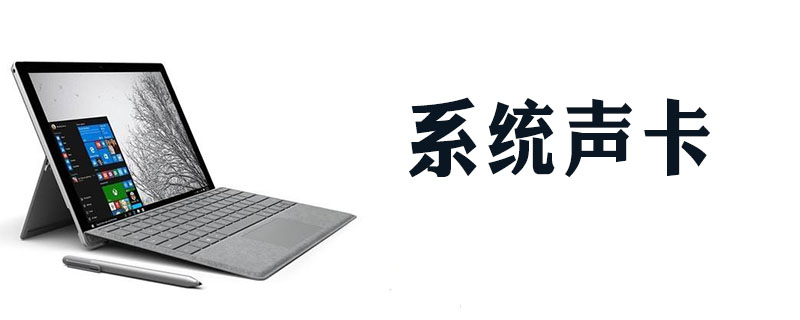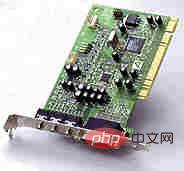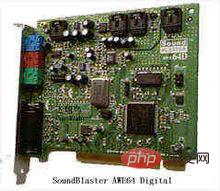 Operation and Maintenance
Operation and Maintenance
 Windows Operation and Maintenance
Windows Operation and Maintenance
 What is the sound card of win7 system?
What is the sound card of win7 system?
What is the sound card of win7 system?

Sound Card (Sound Card) is also called audio card (called sound effect card in Hong Kong and Taiwan): Sound card is the most basic component of multimedia technology, which realizes the mutual conversion of sound waves/digital signals. a piece of hardware.
The basic function of a sound card is to convert the original sound signals from microphones, tapes, and compact discs, and output them to sound equipment such as headphones, speakers, amplifiers, and recorders, or to make musical instruments emit sounds through the Music Equipment Digital Interface (MIDI). Wonderful sound.
Recommended tutorial: Windows system graphic tutorial
Working principle
The sound card obtains the sound analog signal from the microphone, converts the sound wave amplitude signal sample into a series of digital signals through an analog-to-digital converter (ADC), and stores it in the computer. During playback, these digital signals are sent to a digital-to-analog converter (DAC), restored to analog waveforms at the same sampling speed, and then amplified and sent to speakers for sound production. This technology is called pulse code modulation (PCM).

Main functions
Digital sound files. Through the control of the sound card and the corresponding driver, signals from microphones, radio recorders and other sound sources are collected, compressed and stored in the memory or hard disk of the computer system.
The digital sound files compressed by the laser disc are restored into high-quality sound signals, which are amplified and played through the speakers.
Digital sound files are processed to achieve a specific audio effect.
Volume, combine various sound sources to realize the function of reverberation.
Synthesis technology reads text information through the sound card. Such as reading English words and sentences, playing music, etc.
Audio recognition function allows the operator to use passwords to command the computer to work.
Electronic musical instruments. In addition, with the help of the driver, the sound card can output files stored in MIDI format to the corresponding electronic musical instruments and produce corresponding sounds. Make electronic musical instruments commanded by the sound card.

Technical indicators
Sampling rate
The sampling rate refers to the frequency with which samples are collected from the original sound waveform. The higher the sampling rate, the smaller the difference between the recorded sound signal and the original signal. The unit of sampling rate is kHz, and professional sound cards usually provide the following concentrated sampling rates: 32/24/44.1/48/88.2/96kHZ.
Sampling Accuracy
Sampling accuracy value is the accuracy of measuring the volume when performing "analog-to-digital" conversion of sound. Just like a ruler with more precise scales will measure the length more accurately, the higher the sampling accuracy, the more delicate the sound will sound and the less obvious the "digital" taste will be. The sampling precision supported by professional sound cards usually includes: 16bit/18bit/20bit/24bit.
For finished sound products, the most commonly used sound quality standard is 16bit/44.1kHz, which is CD quality. No matter how high the sampling rate and sampling precision is used during recording, when the stereo audio file is finally generated, the sound must be formatted to the CD standard so that it can be played smoothly on most audio equipment.
The advantage of recording with a standard higher than CD sound quality is that if the sound source signal cannot be guaranteed to be highly consistent with the original waveform, then after multiple processes, the difference will increase significantly. In addition, by recording audio with a high sampling rate and sampling accuracy, quantization noise will be reduced to a minimum.
Distortion degree
Distortion degree represents the difference between the processed signal and the original waveform, which is a percentage value. The smaller the value, the more seriously the sound card can record or reproduce the original appearance of the musical work.
Signal-to-noise ratio
The signal-to-noise ratio refers to the ratio of the effective signal to the background noise, expressed as a percentage. The higher the value, the smaller the noise caused by the equipment itself.
The above is the detailed content of What is the sound card of win7 system?. For more information, please follow other related articles on the PHP Chinese website!

Hot AI Tools

Undresser.AI Undress
AI-powered app for creating realistic nude photos

AI Clothes Remover
Online AI tool for removing clothes from photos.

Undress AI Tool
Undress images for free

Clothoff.io
AI clothes remover

AI Hentai Generator
Generate AI Hentai for free.

Hot Article

Hot Tools

Notepad++7.3.1
Easy-to-use and free code editor

SublimeText3 Chinese version
Chinese version, very easy to use

Zend Studio 13.0.1
Powerful PHP integrated development environment

Dreamweaver CS6
Visual web development tools

SublimeText3 Mac version
God-level code editing software (SublimeText3)

Hot Topics
 1378
1378
 52
52
 What should I do if the Win7 taskbar does not display the icon? How to solve the problem of the computer taskbar icon disappearing
Jun 09, 2024 pm 01:49 PM
What should I do if the Win7 taskbar does not display the icon? How to solve the problem of the computer taskbar icon disappearing
Jun 09, 2024 pm 01:49 PM
Recently, many users using Win7 system have found that the icons in the taskbar suddenly disappeared, which makes the operation very inconvenient and they do not know how to solve the problem. This article will introduce to you how to solve the problem of disappearing taskbar icons in Win7 system. Bar! Cause Analysis When encountering such a situation, there are generally two situations: one is that the taskbar on the computer does not really disappear, but is just hidden, and the other is that the taskbar does disappear. Method 1: 1. There is a situation that you need to confirm first, that is, when the mouse is placed at the bottom of the screen, the taskbar will be displayed. You can directly click the mouse on the taskbar and select "Properties". 2. In the dialog box that opens, click & on the "Hide taskbar" option.
 How to clear all desktop background images in Win7? Tips for deleting personalized background images in Win7
Jun 02, 2024 am 09:01 AM
How to clear all desktop background images in Win7? Tips for deleting personalized background images in Win7
Jun 02, 2024 am 09:01 AM
In Win7 system, many users want to delete personalized desktop background images, but do not know how to delete them. This article will show you how to delete personalized background images in Win7 system. 1. First, open the control panel interface of the Win7 system and click to enter the "Appearance and Personalization" settings; 2. Then, in the opened interface, click the "Change Desktop Background" setting; 3. Then, click below "Desktop background" option; 4. Then, select Select all, and then click Clear all. Of course, you can also use it under "Customize", right-click the theme you want to delete, and then click &q on the shortcut menu
 How to add Windows credentials in Win7
Mar 26, 2024 pm 07:46 PM
How to add Windows credentials in Win7
Mar 26, 2024 pm 07:46 PM
1. First, select the Control Panel option in the Start button of the Win7 system. 2. Then in the control panel that pops up, click the [User Accounts and Family Safety] item. 3. Then click [Credential Manager] in the pop-up interface. 4. Finally, click [Add Windows Credentials] to create your credentials. The operation method of adding and managing windows credentials in win7 is shared here in detail with friends. More exciting tutorials are available on the PHP Chinese website!
 Where is the network discovery in Win7? Tips for enabling the network discovery function in Win7
Jun 04, 2024 am 09:02 AM
Where is the network discovery in Win7? Tips for enabling the network discovery function in Win7
Jun 04, 2024 am 09:02 AM
Many computer users know that network discovery is a network setting. This setting will affect whether the computer can find other computers and devices on the network and whether it can find the computer when other computers on the network are found. So how to enable network discovery in win7? The following computer System Home U Disk Installation will introduce you to the tutorial on how to enable network discovery in win7 system. 1. First, click the "Start Menu" icon on the desktop taskbar and choose to open the "Control Panel" interface. 2. Then, in the interface that opens, set "View by" to "Category", and then choose to enter "Network and Internet"
 Introduction to how to change the startup sound of Windows 7 computer
Mar 26, 2024 pm 09:30 PM
Introduction to how to change the startup sound of Windows 7 computer
Mar 26, 2024 pm 09:30 PM
1. First copy the file you want to use as boot music to the corresponding directory of C: WindowsMedia. As shown in the figure: 2. Right-click the desktop on a single machine and select Personalize menu; as shown in the figure: 3. Select the sound option; as shown in the figure: 4. In the [Program Events] box in the [Sound] tab of the sound interface Select [Windows Login], then click [Browse]; as shown in the figure: 5. Select the music file that needs to be replaced, click Open, then click Apply and confirm to save the settings. as the picture shows:
 How to quickly cancel the power-on password of WIN7
Mar 26, 2024 pm 06:56 PM
How to quickly cancel the power-on password of WIN7
Mar 26, 2024 pm 06:56 PM
1. Press win+r to enter the run window, enter [controluserpasswords2] and press Enter. 2. In the user account window, uncheck [To use this machine, the user must enter a username and password (E)], and then click [Apply → OK].
 How to delete vbs virus in win7
Mar 26, 2024 pm 09:21 PM
How to delete vbs virus in win7
Mar 26, 2024 pm 09:21 PM
1. Click [Start → Run] and enter gpedit.msc. On the left side of the [Group Policy] window, click the [Computer Configuration → Windows Settings → Security Settings → Software Restriction Policy] item, and then click the [Action → Create New Policy] menu item. As shown in the picture: 2. Select [Other Rules] from the left. Right-click the blank space in the right pane and select the [New Path Rule] item in the menu. In the pop-up window, click the [Browse] button after [Path], select the wscript.exe file in the C: WindowsSystem32 folder, and set the [Security Level] to [Not Allowed]. Change C: System32, Dllcache and I386 under Windows
 How to modify boot animation in Windows 7
Mar 26, 2024 pm 08:51 PM
How to modify boot animation in Windows 7
Mar 26, 2024 pm 08:51 PM
1. Press and hold the [Win+R] keys to open the run dialog box, enter [regedit] in the search box, and then confirm; as shown in the figure: 2. Open HKEY_LOCAL_MACHINESoftwareMicrosoftWindowsCurrentVersionAuthenticationLogonUIBackgroud in the opened registry editor; as shown in the figure Display: 3. Double-click [OEMBackground] and open it, change the default value [0] to [1], and then confirm to exit; as shown in the figure: 4. Rename the image backgroundDefault.jpg, (the image size cannot exceed 256k



